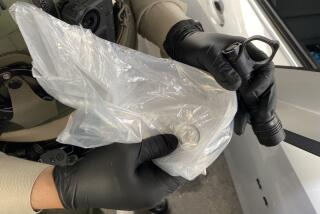One-Man Crusade for Child ID Tags Gains
- Share via
It was the sort of incident that caused even the normally ebullient George Wager to brood.
A 9-year-old La Puente boy, on his way to Little League practice in May, 1983, was struck by a car and suffered severe head injuries. To police, to doctors, to anyone who came in contact with him for six hours after the accident, the boy was a mystery, a child without a name, without a home, without parents, relatives or friends, and without a medical history.
It took six hours to find the boy’s mother, Wager said. The next morning, he recalled, the boy was removed from artificial life support systems and died.
Soon after the boy’s death, Wager, 40, a father of four who coaches Little League in his home city of La Palma and who heard about the accident “through the Little League grapevine,” sat on his porch “watching my kids go off in all different directions--the mall, the playground, around the corner.”
“I was sitting there next to my Great Dane, almost nose to nose, and I looked and saw this tag that said, ‘My name is Brutus and I belong to so-and-so and I live at this address and I’ve had such-and-such shots.’ And I said to myself, ‘Now here is the height of stupidity. This dog has better identification than my kids do.’ ”
Wager decided the need was clear. He designed a plastic laminated tag, about the size of a washing instructions label inside a shirt, that could be fixed or laced onto children’s shoes. The tags had spaces for parents to write the child’s name, address, phone number, doctor’s name and number, insurance company, blood type and other medical information. There was also a space for a parent’s signature, authorizing emergency medical treatment.
Wager, who had made his living designing advertising giveaway promotions, decided to devote all his time to distributing the tags free to anyone who wanted them. He planned to eventually enlist sponsors to pay for materials and cost of distribution.
But the only people who appeared enthusiastic about the idea in the beginning, he said, were the Little League teams to which he distributed the first tags. He contacted national shoe and clothing retailers but found no interest.
For almost three years, Wager sank his family nearly $120,000 into debt, took a second mortgage on his house and “wrote bad checks to try to pay off other bad checks” while he tried to stir up interest in his Lifesaver tags.
Months of Frustration
Now, after months of often frustrating appeals to police agencies, paramedics, ambulance services, small businesses, large retailers and local and national companies, Wager’s nonprofit Anaheim-based corporation, Lifesaver Charities, is almost in the black.
And the demand for the tags, Wager said, is soaring. During the last school year, from September, 1985, to June, 1986, 40 million tags were distributed, and Wager said he expects to distribute 120 million during the next school year. He expects the increase largely because of a story about the tags that appeared in this month’s issue of Reader’s Digest.
Since the article appeared, Wager said, nearly 85,000 letters have poured into his office, requesting more information or asking for tags.
“We’re giving away about a million (tags) a week now,” he said.
In California, he said, the costs of providing the tags are being borne by such companies as Pepsi-Cola, Coca-Cola, Alpha Beta and Lucky supermarkets, banks, real estate companies and local businesses.
But recognition came hard. The first sign of interest was in the summer of 1983 after an article about the tags was published in a national sheriff’s magazine, Wager said. Several small orders from law-enforcement agencies filtered in, but one day a police sergeant from Mitchell, S.D., called Lifesaver Charities and “wanted to know how he’d go about getting 17,000 tags for every kid in Mitchell,” Wager said. “It didn’t take the police long to network.”
Deeper Into Debt
A handful of police agencies around the country began limited distribution of the tags, occasionally with local corporate sponsorships, but it didn’t keep Wager from going deeper into debt.
“I think at that point I kept going just because I was being stubborn,” Wager said. “If you ever want to test your relationship with your wife, just tell her you’re going to take all the equity in your house and sink it into something like this.”
Wager said his bank continued to extend his grace periods, as did the Kimberly-Clark Corp., which developed and provided the light, rip-proof material from which the tags are made. (The original plastic laminated cards tended to crack in cold weather, Wager said. The current tags are designed to be sewn or laced onto shoes, or sewn inside shirt collars and trouser waists where washing instructions usually are attached.)
By Christmas of 1984, Wager was $80,000 in debt, embittered by retailers’ lack of interest.
“It was disastrous,” Wager remembered. “I just sat down on the couch and said, ‘I quit. Nobody wants the things.’ ”
It was around then that Wager’s wife, Kathleen, whose doll-clothing business had been bringing in the Wagers’ only income, showed him a small stack of letters from children in South Dakota and New Jersey, praising the tags.
‘Tears In My Eyes’
“I was just sitting there with tears in my eyes,” Wager said. “After that I just said, ‘Oh, what the hell. Let’s keep going.’ ”
In the weeks that followed, Wager said, contacts from corporate sponsors began to trickle in, offering to pay $30 for each thousand tags imprinted with their corporate logo. Wager’s financial fortunes slowly began to brighten.
Today, Wager said about 10% of his mail is from corporations and businesses, many of them interested in sponsoring tags. Often the letters contain individual requests for tags or words of support.
A paramedic in Greeley, Colo., said she recently treated a 10-year-old bicyclist who had been struck by a bus.
“The child appeared to have a head injury and a broken leg,” wrote Sue Gray, “and not long after our arrival (he) suffered a grand mal seizure. The child had no form of identification or Medic Alert tag, so a medication was administered at the (scene) to stop the seizures, which had become dangerous to the child. Later, a passer-by recognized the child’s bike and was able to give us a name.
“By the time we arrived at the hospital, the child was having respiratory problems. After the parents arrived, we learned that (he) was allergic to the medication we had given. Fortunately (he) recovered after a lengthy stay in the hospital and without lasting effects, but it could have been much worse. Not only was the child allergic to the medication but he also had epilepsy. Without knowing this, (he) could have had unnecessary surgery.
“I can’t begin to tell you how often this type of thing occurs.”
California Enthusiasm Lacking
Although Wager said he has had success in distributing the tags in other parts of the country, enthusiasm has been lacking in California.
Police Officer Terry Branum, spokesman for the Buena Park Police Department, said distribution of the tags in Orange County has been limited, “but we’re kind of playing catch-up now. He’s (Wager’s) had a lot of success back East, and I think now he’s starting to concentrate more on California. The main thing we have to do here, other than distribute the tags, is train police and paramedics and other people to look inside a kid’s shoe or in the shirt collar for the tag. It’s not somewhere you’d normally look.”
So far, he said, Buena Park police have given out about 5,000 tags, mostly at Neighborhood Watch meetings and schools.
Dr. Pete Anderson, director of emergency medicine at Fountain Valley Regional Hospital, said he had not heard of the tags but said “there’s no question that something like that could be helpful to us in certain instances if we knew where to look for it. But I can’t remember ever having a problem identifying a kid (for emergency treatment) within about a 15-minute period. In an emergency, the police are out beating the bushes for the parents, and it usually doesn’t take long.”
Anderson said that in a life-threatening situation “we would do what we had to do” to save a child’s life without waiting for the parents. With a minor injury, he added, doctors probably “would wait a few minutes” before treatment.
Other Forms of Child ID
Wager’s Lifesaver tag is not the only form of medical or personal identification available for children. Perhaps the best known is the Medic Alert bracelet. Distributed by the Medic Alert Foundation, headquartered in Turlock, Calif., the bracelet can contain “whatever information the member requests,” said development assistant Mary Kossart, as long as it contains some medical history.
Medic Alert bracelets cost between $20 and $38, Kossart said, and the wearer is guaranteed lifetime membership in the foundation. Another form of identification, which is being used primarily with children, is the bonding of a microdot containing personal information to one of the child’s molars.
The microdot, about the size of the small “o” on a typewriter, is fastened to the tooth with resin in a procedure that usually takes less than 15 minutes, said Dr. Tom Anderson, an El Toro dentist who performs the procedure. Any information can be printed on the dot, usually the child’s name, address, phone, birth date, medical conditions, allergies and, on occasion, instructions for organ donations, Anderson said. The resin protects the dot, which should be rebonded every five or six years, he said.
Anderson said many dentists would perform the procedure for the cost of the materials. Those who charge for the work, he added, receive an average fee of about $30. Micro I/D Inc., an Illinois company that manufactures what it calls a micro-informational disc, charges $15 for two identical dots.
The dot can be removed with a small pair of needle-nose pliers and read with a 10-power microscope, he said.
Anderson said he has bonded dots to about 20 patients during the last year.
Recommends Microdot
Susan Davidson, executive director of Adam Walsh Resource Center for missing and abused children in Orange, said she recommended the microdot “because if a person’s going to abduct a child, they’d remove an ID tag.”
As for the tags, Lifesaver Charities not only distributes them but now receives royalties from a board game that Wager developed called the Lifesaver Game, to teach children and their parents about safety. And, Wager said, he is developing a model for a school anti-drug program. Lifesaver Charities has become a kind of addiction, he said.
“I never expected it to take three years,” he said. “And what I thought would be something I’d work at a couple of hours a week turned into 60 hours a week. I figured (the tags) would cement my spot in heaven and then I’d go on to something else. Now I can’t imagine doing anything else. I’ve never been so happy doing anything in my life.”
More to Read
Sign up for Essential California
The most important California stories and recommendations in your inbox every morning.
You may occasionally receive promotional content from the Los Angeles Times.













